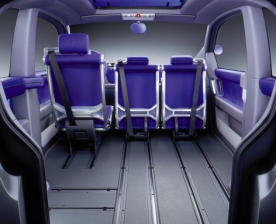
.
. .
.. . . .
. .
Other Pininfarina Other Engineering Companies & Coachbuilder
© 1998 - 2005
Copyright & |
. Pininfarina: M3- Powertrain
Photo: Pininfarina The elimination of the spare wheel enabled us to make use of the whole floor space which could be lowered in order to house technical components. No more spare wheel also meant that specialised axles could be designed with different front and rear solutions: wheels with different diameters, tyres with different specifications. At the front, Pax System technology enabled us to reduce the outer diameter of the tyre/wheel units in order to gain space on the outside of the vehicle. This space gain was achieved without compromising the system’s braking power or load capacity. The choice of tyre size for Pax System (175-490R320 A) provided volume savings of 14 litres, that is to say 22%, with respect to a conventional replaceable tyre size (175/55R14), with the same useable inner wheel volume. Still at the front, the "small" outer diameter of Pax System assembly enabled us to reduce the turning circle: 8 metres with the 175-490R320 A Pax System, 9 metres with the above-mentioned replaceable tyre size. A precious advantage in today’s cluttered streets! At the rear, the aim was to fit as many elements as possible under the chassis in order to free up as much inner space as possible. To achieve this, we minimised the lateral width of the wheel assembly and, by making use of a reducing gear in the wheel, we lowered the transmission shaft as much as possible. We were also able to integrate part of the suspension system into the wheel.The selected Pax System technology tyre size was the 135-610R440 A. A standard replaceable tyre size with the same inner wheel volume would be the 135/70R19. But the outer diameter of this tyre would have led to an increased volume consumption within the vehicle and would have created a visual imbalance in the concept.
In this work Pininfarina has co-operated with technical partners who all contributed their specialist know-how and applications specifically worked out for this new car.The auxiliary power unit by Lombardini is placed at the front integrally with the brushless rare earth magnets generator created by Vickers.The power generated is stored in a pack of batteries supplied by Exide Europe which is also responsible for the battery packaging and technical support.The electric drive system mounted longitudinally at the centre of the car was developed and realised by Siemens AG. The commitment and teamwork of all the partners have been vital to optimise the packaging of the various mechanical components, simultaneously with the development of the chassis. It was an approach that enabled to increase the interior space obtaining an unimaginable roominess for the cabin, not to mention the further advantage of using the combustion engine to recharge the batteries thereby achieving a range of 400 km.From a structural point of view the chassis is made of aluminium, a material that is both lightweight and recyclable. Underlying the vehicle's technological soul is the essential external design characterised by unusual proportions with their own disciplined and refined harmony.
|





